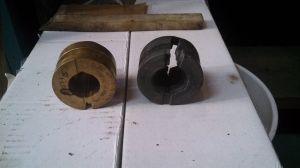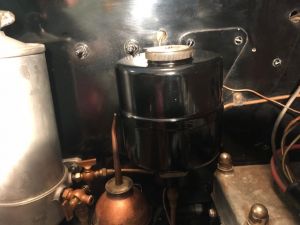- Home
- About Us
- Join/Renew
- Member Benefits
- Member Pages
- Log In
- Help
- Museum Store
Hi, I just purchased a 1928 Model 81 7 pass limo. I was wondering what the “special compound” is for the chassis lubrication unit any foresight into this would be extremely helpful.
Thanks,
Robert Reeves
Hello Robert, congratulations on your new car.
For the Bijur chassis lubrication system, much care must be shown for the actual pump on the firewall. It is made of pot metal, and is quite fragile.
Special compound is like a very heavy weight gear oil. SAE 250wt or heavier.
Most of the Bijur systems have been disconnected and zerk fittings put into the king-pins, spring shackles and other high-wear locations.
Greg Long
Thank you Greg!! It is interesting that they would make the unit out of pot metal but I guess they used what was best at the time
Thanks again,
Robert Reeves
I am not familiar with this particular part but I think “pot metal” is often a misleading term implying poorly controlled junk. Much of what is termed “pot metal” is zinc, which is very well suited to production die casting intricate parts requiring fine detail and high accuracy without subsequent machining steps. It also has good bearing and wear qualities. Zinc isn’t as strong as steel, but a lot stronger than plastics. Because it is cast it tends to have some porosity which gives lots of problems in re-plating. Zinc isn’t free, and there is an incentive by designers to keep walls thin enough to be “mission adequate” which makes them susceptible to decades of use and abuse. The vent wing brackets I am replacing with machined aluminum were zinc, and the original quality is fine, the walls just weren’t thick enough to deal with the overtorqueing of vent windows stuck in old weatherstrip.
Jim
The soft-metal castings used by virtually all manufacturers in the ’20’s and later has the very ‘ugly’ characteristic of not being stable in size. I have never heard of steel, iron, brass, bronze or aluminum growing [cracking] or shrinking [cracking] or otherwise distorting.
The term ‘Pot-Metal’ was derived from [in it’s worst case], from the pot of molten ‘mystery metal’ that was fed with floor-sweepings from around the mills and lathes that were used to clean up and finish producing the cast items.
Therefore there could be unknown contaminants and other odd metals also in the pot, an unknown alloy.
The unfortunate properties of the zinc w/unknown alloying metals are that the metal seems to be ‘alive’ and change shape and become cracked, and very weak, and eventually crumble.
I have speedometer housings that are permanently fixed into instrument panels: the housing was a snug fit originally and the cylinder-shaped housing now has grown in diameter by a couple of percent and the now-larger diameter cylinder cannot be pulled through the steel instrument panel’s opening. It will require destroying the zinc casting or destroying the instrument panel.
Aluminum was a MUCH better ‘white-metal’ for items that needed light weight and strength. Engine crankcases, cylinder heads, pistons, distributor housings etc all have survived well, providing electrolysis did not destroy the inside of the cylinder heads.
But a zinc or pot metal casting like a door handle, or window crank mechanism’s gears, or a tailight mount, those will be found to have changed dimensions, have many cracks and be extremely porous.
Another great example are the clocks and speedometers in the ’29 and later Pierce cars. The pot metal / zinc changes shape which changes the relationship of the gears and pinions in the clock mechanism. This renders the clock useless. The same applies to a speedometer with it’s clock-like mechanism and odometer gears.
The steering wheel shaft where it enters the steering gear box in Series 80 cars, has a pot-metal bushing that grows, splits and because it is fully enclosed in an iron gearbox machined enclosure, the pot-metal bushing then shrinks in diameter, which clamps the steering shaft tightly, rendering the gearbox at the very best ‘difficult’ to steer, in many cases, it simply locks the gearbox solid.
Spun brass taillights and parking light housings are another item that has unfortunate aging characteristics. These items tend to crack and split over time. I do not know if additional annealing could have saved the spun brass items or not. I believe that the spinning process imparts a lot of tension or internal stresses in the brass metal, and possibly an additional annealing
I am far, far from being any type of metallurgist, and am only sharing my experiences and what I have read on these subjects.
It’s too bad that there is not some product like ‘Quik-Poly’ that could be applied to the cracking/porous cast-metal parts, that would solidify the metal, and keep it whole for another 50 years or so.
Greg Long

Taking advantage of this thread, I have a little mystery someone may be able to solve. The attached photos show the chassis lube unit on my Series 81. In photos of the engine compartment of other 81’s, I often see this unit apparently mounted higher on the bulkhead, apparently attached where the photos show a triangle of plat screwed into the bulkhead. There is often also something projecting forward several inches from the bottom of the lube unit. Which makes me wonder, am I missing something on my 81 that ought to be there, or was there an optional bit of equipment that went with the lube unit that mine doesn’t happen to have? Wonder why my lube canister is mounted lower than others? It appears to be in excellent condition, by the way.
Jack Davis

Hello Jack,
Can you take and post another photo with better illumination of the bottom of your lubrication pump?
I agree, the triangle plate is over the original mounting location for the Bijur pump.
The factory pump has a horizontal cylinder under the sheet metal reservoir. This horizontal cylinder under the reservoir is an inch or more longer than the diameter of the reservoir.
I’ll get a photo of an original one tomorrow if I remember.
Greg
This is a Bijur chassis lubrication system which was an option available on the Series 81.
Greg
Herewith photo of the underside of the lube unit. It doesn’t look like something is obviously missing. I wonder of the cylindrical thing projecting down does the same task as the horizontal cylinder on yours and others? It doesn’t look like the unit is disconnected, and there was still half a tank of lubricant in the tank. I gather most owners eventually disconnected the system because it didn’t work very well.
Jack

